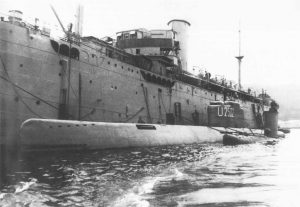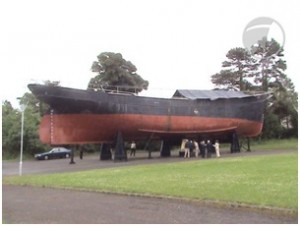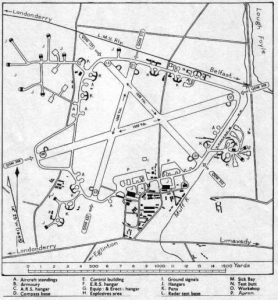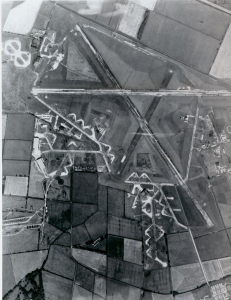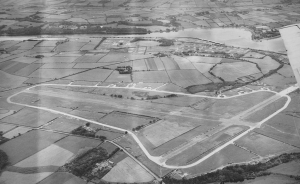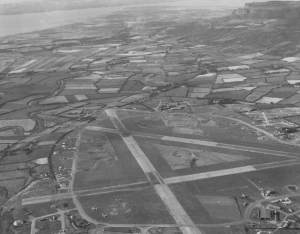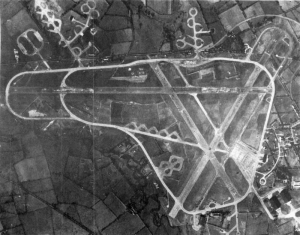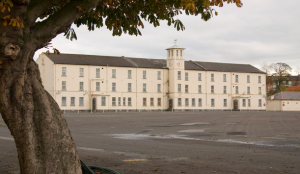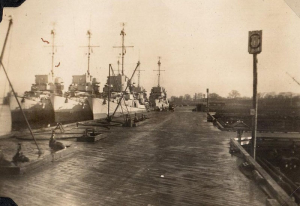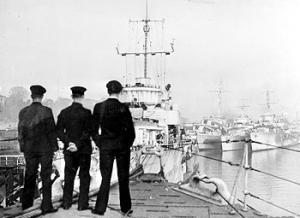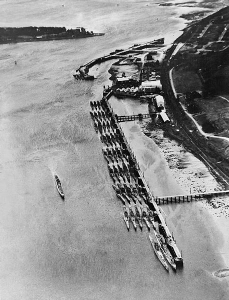WWII Timeline
07 Feb 1924 – HMS Caroline arrives in Belfast
01 Apr 1924 – HMS Caroline officially begins duties as RNVR Ulster Division HQ
09 Dec 1940 – HMS Ferrett established at Ebrington, Londonderry
30 Jun 1941 – First Americans arrive in Londonderry
05 Feb 1942 – Official opening of US Naval Base at Londonderry
01 May 1943 – RAF Maydown transferred to RN
21 Jun 1943 – HMS Gadwall established at Sydenham
15 Aug 1943 – HMS Gannett commissioned at Eglinton
27 Aug 1943 – No 725 NAS formed at Eglinton
14 May 1945 – First eight U-boats surrender at Lisahally
21 Jul 1946 – HMS Sea Eagle ASW training school opened at Ebrington
Units & Ships
HMS Al Rawdah
HMS Al Rawdah was a ship of the Royal Navy. She was built in 1911 and originally christened Chenab for the Nourse Line of London. In 1930 the ship was sold to Khedivial Mail Steamship & Graving Dock and renamed Ville De Beyrouth. In 1939 the ship was sold again and renamed Al Rawdah. In 1940 the British Ministry of Shipping requisitioned the vessel and she was managed by the British-India Steam Navigation Company Ltd.
Between 1940 and 1946 the vessel was used as a military base and prison ship for Irish Republican internees and prisoners. Internment on the Al Rawdah began in 1939 as it was moored just off Killyleagh in Strangford Lough. Some of the Irish detainees placed in the hold of Al Rawdah had also been interned on the British prison ship HMS Argenta.
In 1946 Al Rawdah was returned to her owners, and scrapped in 1953.
More: http://ww2ni.webs.com/countydownpart4.htm
HMS Foxglove
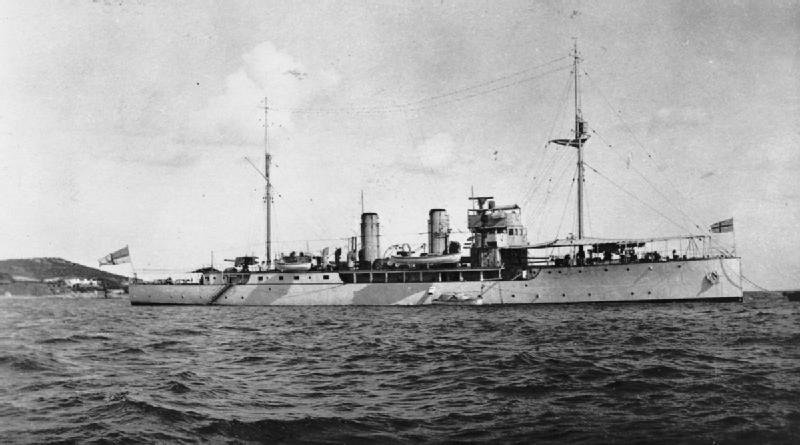
HMS Foxglove (IWM Q98981)
During World War I, Foxglove and the other Acacia-class sloops were used almost exclusively for minesweeping duties until 1917, when the Royal Navy began to use them as convoy escorts, a task to which they were well suited.
HMS Foxglove was one of only two Acacia-class sloops to survive long enough to see service in World War II. She became a loss when she was dive-bombed and badly damaged by German aircraft off the Isle of Wight on 9 July 1940. She remained afloat, and was converted into an accommodation ship and base ship.
In this new role, she became a harbour guard ship in 1941, serving at Londonderry for the remainder of World War II. She was scrapped in 1946.
More: http://ww2ni.webs.com/countylondonderrypt1.htm
HMS Result at the Ulster Transport Museum
Air Stations
RNAS Eglinton (HMS Gannet)
Starting life in 1941 as RAF Eglinton, the air station transferred to the Royal Navy in 1943. HMS Gannet’s principal task was to support the training of fighter pilots and, on 27 August 1943, No. 725 Naval Air Squadron was formed. This squadron was equipped with a variety of aircraft. Among its duties were target-towing so that the fighter pilots could polish their gunnery skills. No. 725 Squadron remained at Eglinton until September 1945.
From February 1944 it was also home to the 1847 Naval Air Squadron which provided convoy air cover as part of the Second Battle of the Atlantic with ten Hellcat 1 aircraft.
April 1959 saw RNAS Eglington close and the Squadrons moved to RAF Ballyhalbert and RAF Ballykelly.
More: http://en.wikipedia.org/wiki/RNAS_Eglinton_(HMS_Gannet)
RNAS Ballykelly (HMS Sealion)
Opened in 1941 as RAF Ballykelly as a RAF Coastal Command base. Runway extended in 1943 but closed at the end of the Second World War in 1945. In 1947 it was re-opened with the Royal Air Force (RAF) Joint Anti-Submarine School training flight.
Further work was carried out in 1962 to prepare for the arrival of displaced Royal Navy (RN) units, following closure of nearby RNAS Eglinton (HMS Gannet) and was referred by the Royal Navy as RNAS Ballykelly.
More: http://en.wikipedia.org/wiki/RNAS_Ballykelly
RNAS Maydown (HMS Shrike)
The station was used by FAA squadrons whilst not on board their ships. There was also a Anti submarine Tactical School.
The airfield was built in 1941 and opened as a satellite station to nearby Eglinton in 1942. It served as a USAAF airfield between August and Dec 1942. It was transferred to the Royal Navy on 1 May 1943 to become RNAS Maydown/HMS Shrike. With the Royal Navy it served by providing aircraft and personnel to the Merchant Aircraft Carriers which became operational in 1943 to provide air cover for the Atlantic Convoys. Many FAA squadrons served from the airfield, flying Walrus, Swordfish, Seafires, Barracudas, Avengers, Wildcats and Corsairs between February 1943 and July 1945. From March 1946 it was home to 3 FAA squadrons, however. 807Sqn arrived on 18 March 1946 and its Seafires remained until 18 May. A detachment of 744Sqn arrived on 1 May 1946, and remained until 27 January 1947. Last in and last to leave were the Seafires of 804Sqn, arriving on 1 October 1946 and leaving on 7 February 1947.
More: http://www.ronaldv.nl/abandoned/airfields/gb/N-Ireland/londonderry.html
RNAS Limavady
RAF Limavady was built in 1940 as a base for anti-submarine patrol aircraft. In January 1944 became a base for Fleet Air Arm 850 Sqn operating Avengers within 15 Group.
The airfield became a satellite to RNAS Eglinton in the 1950s. For the purpose it was provided with a dummy carrier landing deck. Use by the Fleet Air Arm lasted until 1958.
More: http://www.ronaldv.nl/abandoned/airfields/gb/N-Ireland/londonderry.html
RNAS Sydenham (HMS Gadwall)
Sydenham Airport was established by Shorts beside its Belfast factory at Sydenham, Belfast in 1937. This became Belfast’s main civilian airport from 1938 to 1939. The airfield was requisitioned by the Royal Navy during the Second World War in 1943 and named HMS Gadwall. It was used by Royal Navy’s Fleet Air Arm for squadrons disembarking from aircraft carriers and housed an aircraft maintenance yard. It was also responsible for shipping aircraft overseas and had a berth in Belfast Harbour for escort carriers.
The Sydenham airfield continued to be used for military purposes until the 1970s, including use by the Royal Navy’s Fleet Air Arm as a naval aircraft storage unit, after which it was used solely by Shorts.
More: http://en.wikipedia.org/wiki/HMS_Gadwall and http://www.fleetairarmarchive.net/aircraft/Airstations/FAAAirStationsHomepage.htm
RNAS Nutts Corner (HMS Pintail)
RAF Nutts Corner was operational in 1941. It was an important Coastal Command station and was also used as a transport hub for aircraft arriving from the United States. It was used by the Royal Navy during 1945 as a hub.
More: http://www.ronaldv.nl/abandoned/airfields/gb/N-Ireland/antrim.html#nuttscorner
RNAS Ballyhalbert (HMS Corncrake)
RAF Ballyhalbert became operational under Fighter Command in 1941. From 1943 onwards it was used by Polish Squadrons. Eight Fleet Air Arm Squadrons, primarily Fighter Squardons, operated there during 1944 and 1945. In April 1945 the RAF departed handing it over to the RN who renamed it HMS Corncrake. The airfield was decommissioned at the end of WWII.
More: http://www.ronaldv.nl/abandoned/airfields/gb/N-Ireland/down.html#Ballyhalbert
RNAS Kirkiston (HMS Corncrake II)
RAF Kirkiston opened in 1941 and was used by the Fleet Air Arm to work up squadrons prior to embarking on aircraft carriers. A satellite unit to RNAS Ballyhalbert, the airfield was closed in Nov 1945.
More: http://en.wikipedia.org/wiki/RAF_Ballyhalbert
Naval Bases & Harbours
HMNB Londonderry
Falling under Western Approaches Command, Londonderry was home to various convoy Escort Groups, minesweepers, boom defence vessels, examination vessels, target towing vessels, patrol boats, air-sea rescue vessels and tenders during WWII.
Derry-Londonderry played its part in the war effort by hosting not one but two Allied naval bases; ‘Base One Europe’, built in great secrecy by the Americans in 1941 and later called the US Naval Operating Base, Londonderry, and the Royal Naval Base, HMS Ferret.
At the height of the war, Derry-Londonderry was home to thousands of US and British naval personnel, charged with servicing escort vessels that protected Allied merchant ships on their hazardous Atlantic crossings. It also provided respite to the US, British and Canadian crews of those ships.
The statue of ‘The International Sailor’ in Ebrington, once part of HMS Ferret, is dedicated to all those who lost their lives in the Battle of the Atlantic. It mirrors the statue overlooking the harbour in Halifax, Nova Scotia, where the convoys used to gather before heading out to the North Atlantic.
During the conflict Derry was home to 20,000 Royal Navy personnel, some 10,000 Canadians and Newfoundlanders, more than 6,000 Americans as well as men from many of the occupied nations and the soldiers and airmen defending the city and surrounding area.
Between 1939 and 1945 when the city took on the mammoth task of supporting the naval ships and crews from over a dozen nations as they escorted the merchant ships and their valuable cargoes across the North Atlantic.
They faced treacherous conditions again and again for six long years in the Battle of the Atlantic. At any one time there were as many as 140 naval ships and over 30,000 sailors in the port.
Winston Churchill said ‘the only thing that frightened me during the war was the Battle of the Atlantic’ and there’s no doubt that the fact the Foyle was spared a German attack was a factor in the final victory.
Derry was such a unique base because of its proximity to deep water and air fields to allow the combination of both naval and air forces.
Derry’s role in winning the Battle of the Atlantic was recognised by the Royal Navy at the end of the War when Admiral Sir Max Horton travelled to Lisahally along British Prime Minister Basil Brooke to witness on the arrival of surrendered U-boats May 14 1945. USS Robert I Paine was there to represent the US Navy at the surrender. Also present at the ceremony at Lisahally was the head of Irish intelligence, Colonel Dan Bryan, a subtle acknowledgement of the Ireland’s contribution to the effective operation of the Allied naval bases on the Foyle despite the ongoing ‘Emergency’ south of the border.
More: http://www.naval-history.net/xDKWW2-4201-40RNShips3WApproaches.htm and http://www.ireland.com/en-gb/destinations/northern-ireland/articles/derry-ebrington-barracks and http://www.derryjournal.com/news/local-news/derry-was-allies-best-kept-secret-in-battle-of-atlantic-1-5081660
HMNB Londonderry – HMS Ferret
The old Ebrington Barracks (located at the Eastern end of the new peace bridge) were taken over by the navy and commissioned on 9 December 1940 as HMS Ferret. The shipyard at Pennyburn was also taken over as “Fort George”, and used as a ship repair facility, manned by workers from the Harland and Wolff yards at Belfast. Ships based at Ferret were under the control of Western Approaches Command. The function of Ferret was to form escort groups of the warships based there, mostly small destroyers, frigates, corvettes and armed trawlers.
The Destroyers for Bases Agreement was finalised between Winston Churchill and Franklin Roosevelt in September 1940, and fifty ageing American destroyers were transferred to the Royal Navy as the Town class, in return for bases across the empire. As part of the deal four hundred American technicians were transferred to HMS Ferret, arriving on 30 June 1941 and started working in civilian clothes as America was not officially at war. The American personnel later moved out of Ferret and into camps constructed in the area, and on 5 February 1942 a US base was officially established. By 1942 Beach Hill Camp had been commissioned as HMS Ferret III, and the base had become an important centre for anti-submarine training.
After the end of the war, large numbers of captured German U-boats were surrendered to British forces on the Scottish and Irish coasts and were brought to Lisahally. The American base had been transferred to the Royal Navy on 31 October 1944 and then closed on 2 September 1944. The site was commissioned in May 1945 as HMS Ferret IV specifically for the internment. Eventually nearly sixty U-boats were brought in to Ferret IV. After a period of study and other trials, many were sunk off Lisahally and Loch Ryan during late 1945 and 1946 in Operation Deadlight. After this had been completed, Ferret IV was paid off to care and maintenance on 19 July 1946.
After WW2 the Admiralty decided to convert Ferret into a proper school for anti-submarine warfare training. On 21 July 1946 it became HMS Sea Eagle.
More: http://en.wikipedia.org/wiki/HMS_Ferret_(shore_establishment_1940)
HMNB Londonderry – U-boat surrender and disposal
In May 1945 the Royal Naval port at Lisahally, in Lough Foyle near Londonderry in Northern Ireland became a centre of activity for the receipt, processing and ultimate disposal of many of the German U-Boats that had surrendered elsewhere in Europe at the end of the war.
There were two jetties available for the U-Boats: the Admiralty Jetty and the American Jetty, and the first eight U-Boats arrived on 14 May. From then until February 1946, Lisahally was a hive of U-Boat-related activity before, after the sinking of 30 of the U-Boats off Malin Head, and the disposal of others to Russia, America and France, there were just six remaining.
When the U-Boats arrived at Lisahally their senior officers made a formal surrender to Admiral Horton on behalf of the German U-Boat fleet. As well as Admiral Horton, the official party at Lisahally included representatives of the Canadian and US Navies, and personnel from HMS Ferret, RNAS Eglinton (HMS Gannet), RNAS Maydown (HMS Shrike), the Army and RAF Ballykelly. There was also a representative of the Irish Defence Forces, Colonel Dan Bryan. His presence was an acknowledgement of the assistance given by the Irish government in the Battle of the Atlantic.
More: http://www.uboat.net/articles/95.html
HMNB Belfast
Falling under Western Approaches Command, HMS Caroline acted as the base for the Royal Navy in Belfast Harbour during WW2. The port was home to anti-submarine trawlers, minesweepers, examination vessels, patrol craft, degaussing boats, barrage balloon vessels, anti-aircraft vessels, air-sea rescue vessels and offered berths for large vessels including aircraft carriers which used RNAS Sydenham to disembark their aircraft to.
During World War II the Port of Belfast was used by the Royal Navy as the home base for many of the ships that escorted Atlantic and Russian convoys including Captain-Class Frigates of the 3rd Escort Group.
HMS Caroline is a First World War light cruiser permanently berthed in Belfast Harbour and served as the training ship for some 130 reservists as the headquarters for the Ulster Division Royal Naval Reserve. She was the second oldest commissioned warship in the Royal Navy.
Incoming convoy ships which were to go to Bristol or Merseyside would assemble in Belfast Lough off Bangor from where they were provided with a close escort of trawlers which had been converted to Mine Sweeping or Anti-Submarine duties. Over 70 such trawlers were based in Belfast. Outgoing convoy ships would also receive such an escort as far as Londonderry from where Destroyers and Corvettes from the Foyle took over this duty. During the War the Pollock Dock was exclusively for Admiralty use and 20 extra mooring dolphins were installed on the eastern side of the Herdman Channel at Sinclair Road for use by the trawlers used for Convoy Protection.
More: http://www.naval-history.net/xDKWW2-4201-40RNShips3WApproaches.htm and http://en.wikipedia.org/wiki/Port_of_Belfast
HMS Caroline
HMS CAROLINE was the name ship of a class of six light cruisers built by Cammell Laird in time for the outbreak of the Great War. Launched and commissioned in 1914 she joined the Grand Fleet at Scapa Flow. In 1916 she was engaged in the Battle of Jutland. Until she was decommissioned in 2011 she was the second oldest commissioned warship in the Royal Navy after HMS Victory.
During the Second World War, Caroline served as the Royal Navy’s headquarters in Belfast Harbour which was used as a home base by many of the warships escorting Atlantic and Arctic convoys, including Captain-class frigates of the 3rd Escort Group.
As Belfast developed into a major naval base during the Second World War, its headquarters outgrew the confines of HMS Caroline herself and occupied different establishments in various parts of the city. Eventually several thousand ratings were wearing Caroline cap tallies. The first such establishment was set up in the Belfast Custom House. Later, Belfast Castle was taken over and included a radio station. There were depth charge pistol and Hedgehog repair workshops associated with HMS Caroline, some of which would have been on the quays beside her berth in Milewater Basin.
During the early part of the Second World War when the Royal Navy occupied Sydenham (Belfast harbour) airfield, Fleet Air Arm personnel based there were lodged under HMS Caroline.
After the Second World War, the Royal Navy returned Caroline to the Royal Naval Volunteer Reserve, and she served as its last afloat training establishment. She underwent a refit at Harland and Wolff in Belfast in 1951.
The Royal Naval Reserve Unit decommissioned from the ship in December 2009, moved ashore, and recommissioned as the “stone frigate” (i.e., shore establishment) HMS Hibernia. Caroline herself was decommissioned on 31 March 2011 in a traditional ceremony. Her ensign was laid up in St Anne’s Cathedral in Belfast.
October 2012 the Northern Ireland government announced that the ship would remain in Belfast and that the National Heritage Memorial Fund had pledged £1,000,000 to help to restore her. In May 2013 the Heritage Lottery Fund announced an £845,600 grant to support conversion work as a museum.
More: http://www.nationalhistoricships.org.uk/register/430/hms-caroline and http://en.wikipedia.org/wiki/HMS_Caroline_(1914)
HMNB Larne
Falling under Western Approaches Command, Larne was home to the base ship HMS Racer, anti-submarine trawlers, motor launches, examination vessels and air-sea rescue boats during WW2.
More: http://www.naval-history.net/xDKWW2-4201-40RNShips3WApproaches.htm
Other Locations
Belvoir Park Armaments Depot
The Admiralty took charge of Belvoir Estate at the start of the war and used it as a temporary Armament Depot. There were 131 buildings, mostly nissen huts, erected around the estate. The River Lagan was used to moved munitions, mostly shells and torpedoes, to and from Belvoir Park and Belfast Harbour.
More: http://ww2ni.webs.com/greaterbelfastpart1.htm
Belfast Castle
A plaque is located in the foyer of Belfast Castle to commemorate is use as Headquarters for the Flag Officer Commanding Royal Navy between 1941 and 1946.
More: http://ww2ni.webs.com/greaterbelfastpart2.htm
Islandmagee Battery Gunnery Range
This four gun battery was used by Royal Navy, Merchant Navy and Soldiers and Marines from armed Merchant ships to conduct practice firing with 120mm and 12-pound guns during WW2.
More: http://ww2ni.webs.com/countyantrimpart2.htm
Portrush Direction Finding Radar
The Royal Navy operated a D.F. (Direction Finding) Radar station which was positioned on Ramore Head in Portrush during WW2.
More: http://ww2ni.webs.com/countyantrimpart2.htm
Lough Neagh Bombing Range
There was a Bombing Target Range on Skandy Tower Island in Lough Neagh which was used by the Fleet Air Arm of the Royal Navy during WW2.
More: http://ww2ni.webs.com/countyantrimpart3.htm
Orlock Submarine Indicator Loop
During WW2 a submarine Indicator Loop was laid on the seabed from Sandeel Bay at Orlock in County Down to Black Head in County Antrim. This electrical cable was used to detect any submarine which passed over it. Action could then be taken by the Royal Navy Extended Defence Officer at Orlock to detonate an electrically operated minefield.
More: http://ww2ni.webs.com/countydownpart1.htm
Portballintrae Submarine Indicator Loop
Can be seen on the beach at Portballintrae. From the main Car Park walk towards the bay which is used by surfers and on looking towards the sea this Submarine Indicator Loop will be on your left.
More: http://ww2ni.webs.com/countyantrimpart2.htm
Grey Point Fort
Grey Point Fort is one of the best preserved early 20th century coastal forts anywhere in the British Isles. Situated in Helen’s Bay, Grey Point Fort houses a most unusual hands-on military museum. It also hosts a number of special commemorative events during the year. The Fort was completed in 1907 with at its heart two massive 6 inch diameter guns which commanded the entrance to Belfast Lough. While a key part of Belfast’s defences against naval attack, it proved of limited value during the German air attacks on the city in 1941. There are still two magnificent 23 feet long guns.
More: http://ww2ni.webs.com/countydownpart2.htm
Kilnappy (Co Londonderry) Royal Navy Armament Depot
The Kilnappy Royal Naval Armament Torpedo and Mine Depot covers an area of 47 Acres. It stored various armament types including Torpedoes and Depth Charges.
More: http://ww2ni.webs.com/countylondonderrypt1.htm

